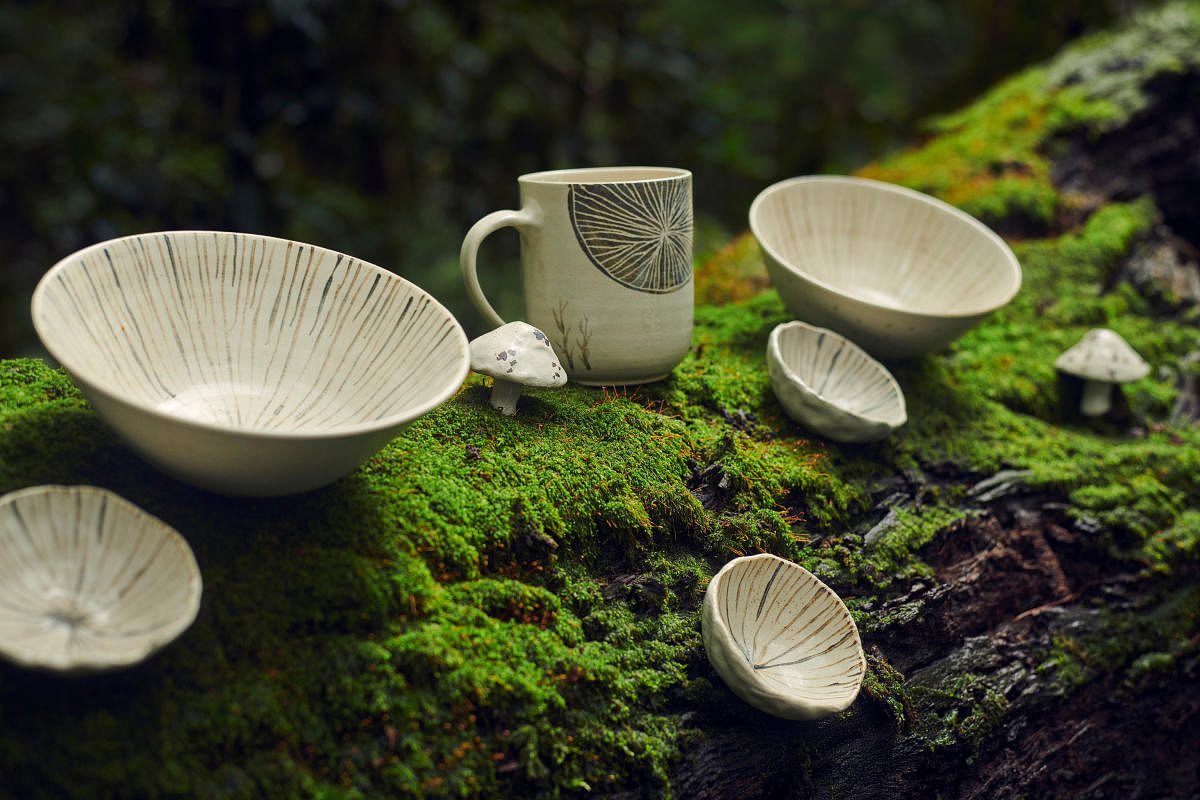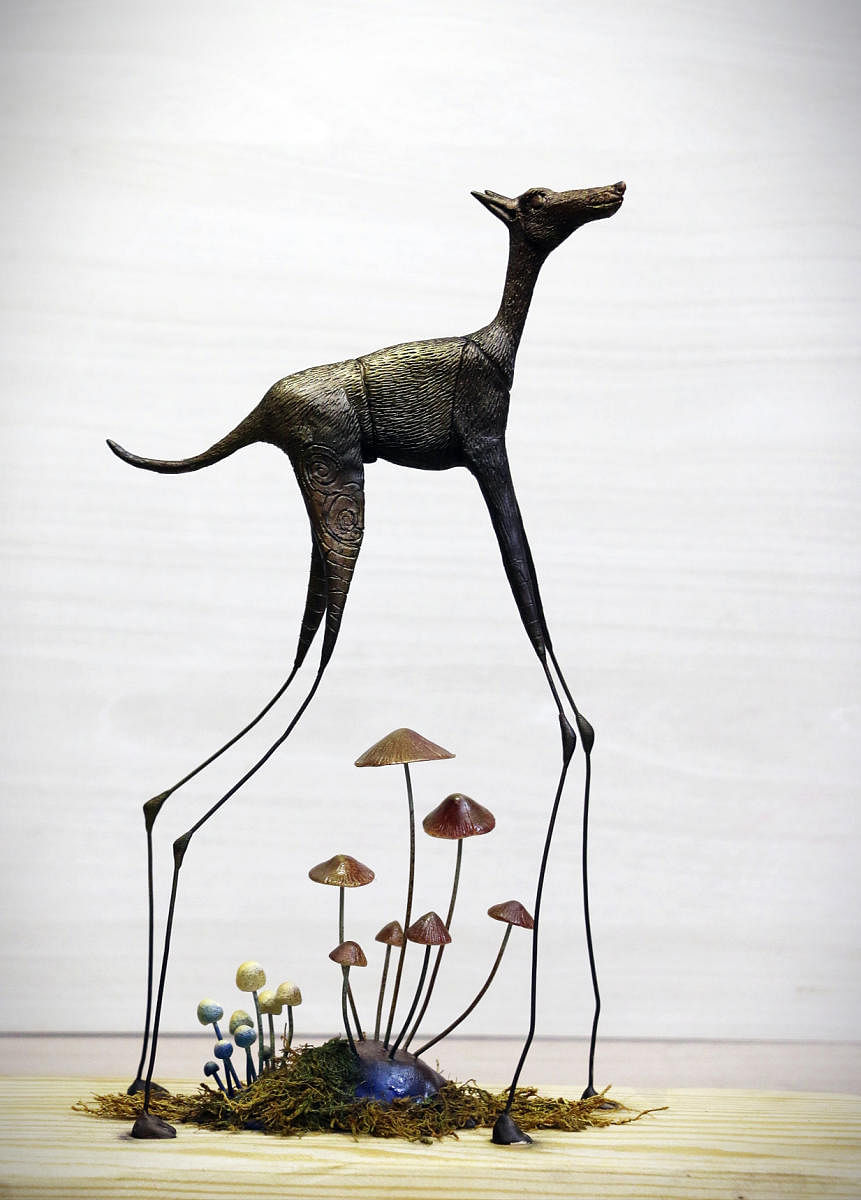

Like in nature, mushrooms are popping up in unexpected places in the material world.
Delhi-based fashion designer Rahul Mishra has unveiled silhouettes mimicking mushrooms that grow on tree stumps. New York jewellery brand Brent Neale has done pendants with magic mushroom centrepieces. Fly Agaric, the red-capped fungi with white dots, has permeated our pillows to doormats and socks, bringing home fantasy akin to ‘Alice In Wonderland’. Then in 2021, mushroom-shaped glass lamps from Murano, Italy, were a hot decor trend.
Look up Mylo by Bolt Threads in California. A leather alternative from mycelium, the root-like network under fungi, it is on Stella McCartney’s line of bustier, trouser, and handbag, and a concept shoe by Adidas. The NASA is prototyping technology to grow houses on the Moon from the mycelia. New York’s Evocative Design has even piloted home insulation with mycelia.
Diversity in forms
Product designer Ayushi Rastogi looks for shapes and textures in nature for inspiration. The Mushroom Series is a limited edition of bowls, mugs and vases, inspired by the Shola forests of the Nilgiris in Coonoor, where her ceramic studio Ayra is situated.
She has reimagined the inverted head of pholiotina, a tawny-brown mushroom, as bowls. Long and tubular, her vases take after the coral mushroom. On mugs, she has painted the gills of orange mycena, a bell-shaped mushroom, to draw attention to the oft-ignored papery structures that grow underside and produce spores.
Mumbai-based Harshita Jhamtani also looks up to nature for silhouettes. Shroom, a stoneware console lamp from her Earth Collection, was inspired by umbrella-shaped mushrooms. However, she was not thinking of mushrooms when she designed table and floor lamps for Kasa, her latest series. But her Instagram followers saw just that in her lampshades, the shape of a pointed Japanese hat hoisted on stalks, and the name ‘mushroom lamps’ has stuck since.
In Kerala, SWA Diamonds styled their pièce de résistance after the pink oyster mushroom. They set a Guinness record in May by setting 24,679 natural diamonds on an 18k gold ring, the most ever.
Chief designer Rijisha T V sifted through forms like sari pleats to ribbon patterns and temple tombs to fish gills before settling on the fungi. She explains, “I wanted a form with more surface area, curves, pleats and layers to accommodate the maximum diamonds. Plus, the oyster mushroom looked different from the usual, umbrella-like mushrooms.” The ring had to be dismantled to count the diamonds and the petal-like structure scored on the practical front too.
Art teacher and naturalist from Bengaluru, Deepak R, is currently sculpting Phallus indusiatus, a stinky mushroom that grows a lazy skirt around it. “Mushrooms range from 2-3 mm in size to 5-6 kg in weight” and this diversity, he says, is a springboard for design inspiration.
Diversity — an estimated 62.8 lakh species of mushrooms — has deeper meanings for queer artistes. Malavika Bhatia, who is selling T-shirts printed with mushrooms as part of the foraging walks they organise in Delhi, says, “In Percy Bysshe Shelley’s Gothic poems, for instance, mushrooms were represented as monstrous and repulsive. Artistes from the queer community are drawn to this perception of monstrosity and also the diversity the world of mushrooms presents,” they explain.
Food for thought
Mushrooms in design have emerged from the growing interest around them in science, medicine (calls to legalise psilocybin and psilocin, the main psychoactive ingredients in
magic mushrooms, gain steam), fashion, food, and foraging tours.
‘Fantastic Fungi’, a documentary that argues that fungal diversity can save the world from plastic pollution to environmental contamination, has been a catalyst, Jashid Hameed, who runs a mushroom lifestyle brand Nuvedo in Bengaluru, points out.
Fungi is also abound in metaphors. A hobby artist, he makes mixed media art on mushrooms, edgy but spiritual. “They represent the dichotomy of life and death,” he talks about the ‘nature’s recyclers’, which grow from the dead but also break down dead matter.
‘Life After Death’, a sculpture series Deepak has done using polymer clay, wire, metal, wood and fibre, dwells on a post-apocalyptic world. In ‘The Happy Hare’, a rabbit looks for mushrooms without realising it is growing on its back, a commentary on how fungi are everywhere yet hidden from our consciousness. In ‘The Guardian’, a dog protects mushrooms, which “are among the first life forms that sprout after the destruction”.
Mushrooms are also symbols of royalty, good fortune, fertility, and immortality. These metaphors, Rijisha felt, elevated the significance of the diamond ring, hence the team called it ‘The Touch of Ami’ — Ami means immortality in Sanskrit.
Art critic Giridhar Khasnis weighs in on the fungi fixation: “Good art attracts as well as pushes the viewer away. Mushrooms do the same. They pop out of nowhere, mysteriously. They have unusual shapes and textures. But for all your curiosity, you will think twice before going to pick or eat them because they are thought to be poisonous.”
Mycelium as material
Dharaksha Ecosolutions from Faridabad has created a biodegradable alternative to styrofoam packaging — from a mix of agricultural waste and fungal mycelium. “It doesn’t catch fire till 1,200°F, decomposes in 60 days, and can also be moulded as lampshades and plant pots,” chief scientist Sharad Rai shares. Work is on to cut the production time from 10-15 days to a week and the cost by 40-60%, and make mycelium leather and foam.
Architecture out of mushrooms — mycotecture — exists too. In 2017, Asif Rahman Junaid was among the trio of architects who built Shell Mycelium, a temporary pavilion at a biennale in Kerala, by growing mycelium on coir waste. Mycelium is lightweight, easy to mould, consumes less water to grow, and doesn’t present the demolition and disposal challenges that concrete structures do, he explains the advantages. This July, with a former collaborator, he unveiled a lego-like installation of mycelium grown on wooden logs at an indoor fest. Both times, milky mushrooms, an Indian species, were used. “The first venue was outdoor, so the heat and humidity posed a threat to the mycelial structure,” he says.